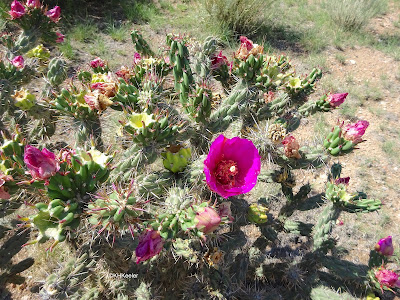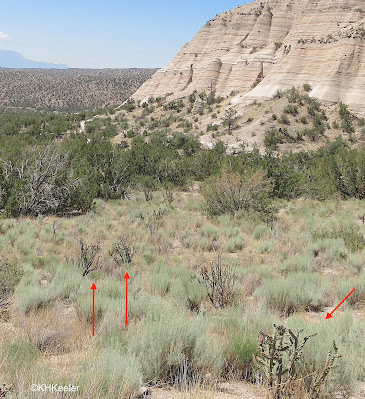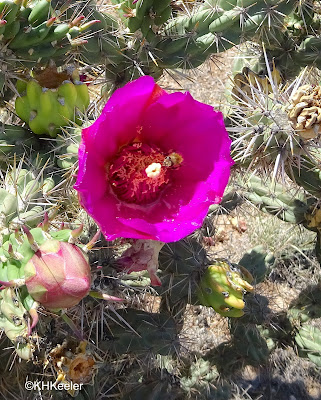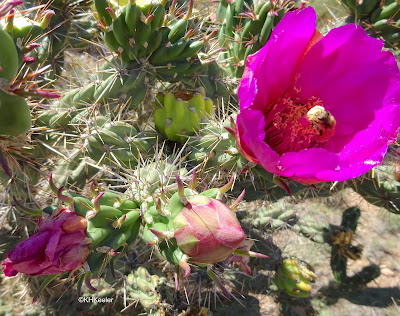Visiting New Mexico, you can't miss the big cacti. Prickly pears stand two to three feet tall, not hugging the ground like the ones in Colorado. Chollas can be more than eight feet tall.
In July, the tree cholla (Cylindropuntia imbricata) was flower. With deep rose-purple flowers, it was doubly noticeable.
 |
| tree cholla, Cylindopuntia imbricata, in flower |
 |
| tree chollas in New Mexico landscape |
The tree cholla is found across New Mexico and Texas, south into northern Mexico, a little west to Arizona and Nevada and north to southern Colorado and southwestern Kansas, at elevations from 4,000-7,500 ft. Across most of that area there is nothing like it for height and shape. Furthermore, it holds its yellow fruits most of the year.
It is also called cane cholla, walking stick cholla, candelabrum cactus, cardenche, chainlink cactus, coyonostyle, shrub cactus, velas de coyote (coyote candles), xoconochtle, and, Australia where it is a bad weed, devil's rope cactus, and devil's rope pears. It is conspicuous, so it probably has additional common names that are used locally.
The scientific name is Cylindropuntia imbricata, which changed from Opuntia imbricata some years ago, when the very big genus Opuntia was broken up. The name Opuntia is based on the Greek town of Opus, meaning "a plant found in Opus," but that was some other plant, since opuntias are New World. Cylindr-, which means cylinder, refers to the long narrow stems that distinguish chollas from prickly pears. The species epithet, imbricata, means "closely overlapping" but my sources don't tell me what the botanist that named it saw as overlapping.
 |
| tree cholla |
Delighted by the big cactus flowers, I took dozens of photos. Bees visit the flowers. My photos show honey bees, but native bees pollinate too.
 |
| tree cholla flower, honey bee, Santa Fe, NM |
Furthermore, I spotted ants. Ants are little predators, and when you add all the ants of an area together, they are usually the biggest predator in the ecosystem! A big predator with the curious ability to be in many places at once. Worker ants like nectar, sugar water, but the ant larvae in the nest require meat. So the workers snack on nectar when they find it, but are out looking for food for the ant larvae.
Some plants exploit that by offering nectar, encouraging ants to visit. Pollinators are rewarded for visiting by nectar as well, but ants aren't good pollinators. Since they don't fly, ants generally visit flowers on the same plant, so will not carry out the cross pollination between plants that produces the best seeds. In addition, ants clean each other, removing pollen. Nectaries not in the flower, called extrafloral nectaries encourage ants to come to the plant, and if they find prey such as insect larvae, remove it from the plant to feed to their own larvae, without inviting ants into the flower. Extrafloral nectaries occur in maybe 5,000 plant species (they are small and probably the reports are incomplete (World List) ) but are relatively common in legumes (acacias for example), mallows such as hibiscus, and, surprisingly, cacti.
 |
| ants and extrafloral nectaries red dots are nectaries, ants are black |
Mauseth, Rebmann, and Machado made a list of dozens species of cacti with extrafloral nectaries, and thought there were many more. The genera Coryphantha, Cylindropuntia, Ferocactus, Opuntia, Sclerocactus, and Thelocactus have many species known to have extrafloral nectaries, but so does the giant saguaro, Carnegia, which is the only member of its genus.
 |
| ant on the flower bud The bud is a likely place for a tiny extrafloral nectary but the ant could just be foraging |
Tree cholla has not been studied, but presumably the visiting ants benefit it.
Ants are a mixed blessing to plants, however. If they can reach the floral nectar, they will gather it, depriving pollinators. Sometimes ants attack pollinators, driving them off. Or their presence--movement--on the flower causes wary potential pollinators to fly elsewhere. Ants can also damage the plant, digging into the area of the extrafloral nectary for more nectar, letting bacteria and fungi in. But ants are very numerous, so plants have to deal with them. In some species, like the senita cactus, the extrafloral nectaries definitely distract the ants from foraging in the flower. (Flower structure often discourages ants as well; to walk into a cholla flower the ant must cross a row of pointy bracts, walk nearly upside down along the underside of the sepals, and then make a 270º turn onto the upper surface of the sepal; pollinators just fly in.) Extrafloral nectaries can certainly both attract ants to prey upon the plant's herbivores and lure them away from the floral nectaries.
 |
| such spectacular flowers |
References
Holland, J. N., S. A. Chamberlain and T. E. X. Miller. 2011. Consequences of ants and extrafloral nectar for a pollinating seed-consuming mutualism: ant satiation, floral distraction or plant defense? Oikos. 120: 381-388.
Mauseth, J. D., J. P. Rebmann, and S. R. Machado. 2016. Extrafloral nectaries in cacti. Cactus and Succulents Journal. 88 (4)' 156-171.
Pickett, C. H. and W. D. Clark. 1979. The function of extrafloral nectaries in Opuntia acanthocarpa (Cactaceae). American Journal of Botany. 66 (6): 618-625.
Pinkava, D. J. 2020. Cylindropuntia imbricata (Hayworth) F. M. Knuth Flora of North America link Accessed 9/14/21.
Weber, M. G. and K.H. Keeler 2013 Phylogenetic distribution of extrafloral nectaries in plants. Annals of Botany 111: 1151-1161.
Kathy Keeler, A Wandering Botanist
More at awanderingbotanist.com
If you still came to read a similar article, then you should be interested in the topic of floristry, flowers and other things like that. I can recommend flower shop as there you can find enough information about the design of flowers, bouquets and everything related to the floral theme
ReplyDeleteThanks for an interesting and informative article on the tree ring, extra nectar glands and ants. Your blog provides fascinating scientific research, expanding our understanding of nature and the interactions between different species. In this regard, I would like to note that attending these beauty courses can also be an exciting way to gain new knowledge. Beauty courses provide an opportunity to learn a variety of skincare, makeup and hair styling techniques that will help you enhance your natural beauty and confidence.
ReplyDelete